The Complex Dynamics of Bertrand-Stackelberg Pricing Models in a Risk-Averse Supply Chain
Abstract
We construct dynamic Bertrand-Stackelberg pricing models including two manufacturers and a common retailer in a risk-averse supply chain with the uncertain demand. The risk-averse supply chain follows these strategies: Bertrand game between the two manufacturers and Stackelberg game between the manufacturer and the retailer. We study the effect of the price adjustment speed, the risk preference, and the uncertain demand on the stability of the risk-averse supply chain using bifurcation, power spectrum, attractor, and so forth. It is observed that there exists slip bifurcation when the price adjustment speed across some critical value, the stable region, and total profit of the risk-averse supply chain will increase with increase of and decrease with increase of σ. The profit of the supply chain and the two manufacturers will decrease and the weaker (retailer) is a beneficiary when the supply chain is in chaos. The fluctuation in the supply chain can be gradually controlled by the control of the price adjustment speed.
1. Introduction
With the development of economic globalization, the relationship among the supply chain members becomes more and more complex under the different environment. An enterprise which is involved in the middle of multiple supply chains has all kinds of complicated relationship when the parameter of the upstream and downstream enterprises is changed, such as market uncertainty and risk preference factor; the enterprise’s decision-making behaviors become more complicated and hard to predict.
We all know that the price is always a sensitive topic, which can affect customer needs and wants, distribution of the products and services among the supply chains. Scholars at home and abroad have done a lot of research on this aspect. Wei et al. [1] studied pricing decisions in a supply chain with two manufacturers and one common retailer and constructed five pricing models under decentralized decision cases with consideration of different market power structures. Mukhopadhyay et al. [2] considered two separate firms, which had private forecast information about market uncertainties and offered complement goods in a leader-follower type, and devised a “simple to implement” information sharing scheme under which both firms and the total system are better off. These literatures analyzed and compared the optimal solution under different market power structures, but they did not consider the effect of risk reference of the participants on the optimal solution.
There are many literatures taking risk preference into account. Caliskan-Demirag et al. [3] constructed models of the supply chain with a risk-averse retailer by adopting the conditional-value-at-risk (CVaR) decision criterion. Luo and Huang [4] explored the impact of risk preference on the strategies of the supply chain by taking the different attention of high profit and low profit as retailers risk measurement. These literatures only consider the unilateral risk, but, in the uncertainty environment, there exists bilateral risk among the participants which corresponds to the actual situation. In this paper, we will consider a supply chain under bilateral risk with two risk-averse manufacturers and a risk-averse retailer, which make the supply chain more complex.
Many literatures study the complexity of supply chain. Huang and Chen [5] studied the sale-surety contract option of supply chain with effort dependent demand and risk preference and got some meaningful conclusions. Guan and Zhou [6] researched the integrated optimization problem of three-level supply chain consisting of suppliers, distributors, and retailers under decision-makers having different risk attitude. Huang and Yang [7] studied a two-echelon supply chain model with one supplier and one retailer in a newsvendor problem; the supplier with different risk attitude has great influence on the retailer’s optimal order quantity; the operation efficiency of the supply chain will be underperformed when the supplier is much too risk-averse. These literatures have studied the participant’s behaviors of the risk supply chain, but they did not present the dynamic complex features of the risk supply chain.
Research on dynamical complexity of a system has been of concern to scholars. Puu [8] found that the Cournot three oligopoly model could appear strange attractors with fractal dimension, and he studied the situation of the duopoly game. Many researchers improved the classical Cournot model and found that certain dynamical behaviors of the system occurred in the course of repeated games with three or four duopolies. Many experts have also studied this field under different conditions, such as different expectations and incomplete information select it Ma and Sun [9] established a decentralized pricing game model and studied its complex dynamic characteristics of triopoly under different decision-making rule; the result showed that the process of game would tend to a Nash equilibrium at a lower price adjustment speed, and, with the increase of the value of adjustment speed, the system would appear to be unstable and gradually gone into a chaos state. Ma and Bangura [10] studied the dynamic complexity of financial and economic system under the condition of three parameters changing.
In recent years, many experts apply the dynamical complexity to study the dynamic change process of supply chain. Hwarng and Xie [11] found that there existed the chaotic enlargement phenomenon among the members of the supply chain which enriched the connotation of the bullwhip effect. J. Wang and X. Wang [12] established nonlinear supply chain inventory system models with forbidden returning and limited supply capacity; numerable simulations showed that the supply chain inventory system had complex dynamic behaviors under certain parameter settings; they gave some suggestions to eliminate the complexity of the dynamic supply chain. Ma and Feng [13] presented investigation simulations of retailer’s demand and stock; the behaviors of the system exhibited deterministic chaos with consideration of system constraints. These literatures researched the dynamic complexity of the supply chain but did not consider the influence of the decision-maker’s risk behaviors on the supply chain management. In this paper, we will study the dynamic complexity of a risk-averse supply chain with two manufacturers and a common retailer under uncertain demand. Considering the change of parameters in the dynamic risk supply chain, such as the price adjustment speed, risk preference, and uncertain demand, we can study the influence of parameters on the price and stable region of the two manufacturers and retailer.
The remainder of this paper is organized as follows. In Section 2, we describe the supply chain problem, make assumptions of the system model, and discuss the system model. In Section 3, we construct a Bertrand-Stackelberg dynamic pricing model which consists of two manufactures and one retailer with risk-averse attitude. Analysis is made under different variable conditions in Section 4. In Section 5, the variable feedback control method will be used to control chaos in the system. In Section 6, we outline some conclusions and hence relevant recommendations for future research.
2. Model
2.1. Description of the Problem
In this section, we construct a dynamic pricing game model in a risk-averse supply chain which consists of two manufacturers (M1 and M2) and a common retailer (R). The two manufacturers are competitive and sell respective products to the common retailer, and the common retailer sells two kinds of products to consumers directly. The customers’ demand is stochastic. We consider the supply chain following these strategies: Bertrand game between the two manufacturers and Stackelberg game between the manufacturer and the retailer. In these strategies, the two manufacturers and the retailer make their own decisions, respectively, for maximizing their profit; the decision process is as follows: the two manufacturers, as the Stackelberg leader, determine the respective wholesale price (wi) (i = 1,2); the retailer as the follower sets his own optimal retail price (pi) (i = 1,2) based on the manufacturer’s decisions.
Furthermore, in order to capture the uncertain demand which is affected by the change of economic and business conditions and prediction errors, we assume the market demand random variable a is as follows: , where is the primary demand level and ε follows a normal distribution such as E(ε) = 0, Var(ε) = σ2. However, the normality assumption has been used extensively in the literature (e.g., Gal-Or [14]; Raju and Roy [15]; Vives [16]). The two manufacturers and the retailer know the distribution of the uncertain demand and determine their behaviors, respectively.
Because the customer demand is stochastic, there is financial risk to the two manufacturers and the retailer. Therefore, we should consider the effect of the risk preference of the two manufacturers and the retailer on pricing decision. The preference theory provides the framework which incorporates the participators’ financial risk preference into their decision process. The valuation measure we use is known as the certainty equivalent in the preference theory and is defined as certain value that a participator is just willing to accept an uncertain event (Kunstman [17]).
One form of the utility function in both theoretical and applied work in areas of decision theory and finance is the exponential utility function which can be expressed as (i = M1, M2, R), where Ri is the risk tolerance level of the two manufacturers and retailer, πi is the profit, and e is the exponential constant. When Ri < ∞, it implies that the decision-maker has risk-averse behavior, and Ri approaches ∞ which implies the decision-maker is risk-neutral (Walls [18]). If the decision-maker is risk-averse, π follows a normal distribution, and expected utility is E(U) = E(π) − (Var(π)/2R), where E(π) is the mean of π and Var(π) is the variance of π.
2.2. Assumption of the System
- (1)
Customer demand is always satisfied, demand function is linear, and the two manufacturers and the retailer make decentralized decision.
- (2)
We consider two partly substitutable products coming from a competitive market in which consumers can buy any one of them.
- (3)
The consumer demand is stochastic; the two manufacturers and the retailer are all risk aversion.
- (4)
is marginal cost of M1; is marginal cost of M2.
2.3. Revenue Function of the System
In this study, wi and pi (i = 1,2) are decision variables and other variables are exogenous variables. As is known in the supply chain, we assume that pi ≥ wi (i = 1,2); this inequality ensures that each participant can obtain a positive profit.
3. Bertrand-Stackelberg Model
4. The Complex Dynamic Behavior
The ultimate goal of the supply chain is to pursue profit maximization for each of the participants and to achieve optimum overall. Therefore, they should adjust price based on their marginal profit of last period.
4.1. The Fixed Point
In system (8), letting wi(t + 1) = wi(t)(i = 1,2), we can get the fixed points of system (8). Before we solve the fixed points of system (8), we first assign some parameters considering the actual competition: , and . We will calculate all the fixed points and only consider the Nash equilibrium point (w1 = 31.22, w2 = 26.33, p1 = 37.37, and p2 = 36.59).
4.2. The Effect of Price Adjustment Speed on the System
(1) The Influence Which the Price Adjustment Speed Has on the Behaviors of the Two Manufacturers and the Retailer. Since the two manufacturers’ behaviors are similar, we only discuss the influence on system behaviors when the parameter of M1 is changed.
First, we can get the price trajectory diagrams of the two manufacturers and retailer with change of k1 when k2 = 0.001, w1 = 20, and w2 = 15, as shown in Figure 1(a) and Figure 1(b). We can obtain that w2 is less affected by change of k1 and w1, w2, p1, and p2 change from the stable period, period-doubling bifurcation to the chaos in three trajectories. When k1 ∈ [0,0.00102], w1, w2, p1, and p2 are stable. When k1 = 0.00102, the first bifurcation appears in w1, w2, p1, and p2, and the price of the two manufacturers and retailer vibrates in two points; after that the second bifurcation appears in the system; finally, the system goes into chaos, the price behaves more disorderly, and the market behaviors become unpredictable. Figure 1(c) shows corresponding change of the Lyapunov exponent. The positive Lyapunov exponent is used to mark the chaos; the bigger the Lyapunov exponent, the stronger the chaos. The system is in chaos when most of the Lyapunov exponents are positive. Figure 2 shows the price trajectory diagrams of the two manufacturers and retailer with the change of k1 and k2 simultaneously. We can observe that the stable regions of w1, w2 are smaller than the one with change of only k1 or only k2 and the w1, p1, and p2 change from the stable period and period-doubling bifurcation to the chaos in four trajectories; the dynamic characteristics of w2 in particular do not follow the period-doubling bifurcation. Because k1 and k2 change at the same time, the retailer’s behaviors appear in complicated characteristics.
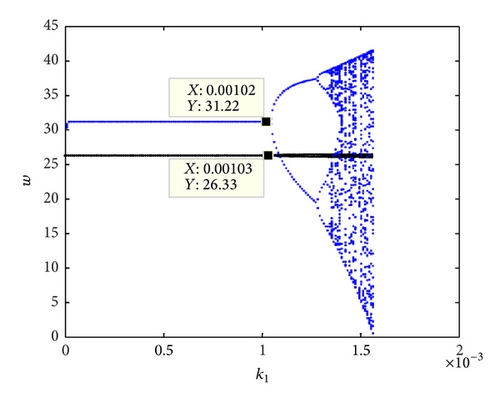
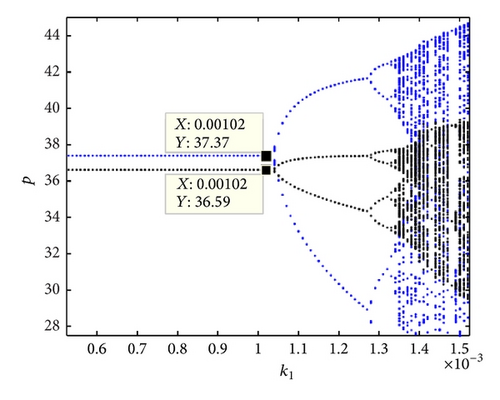
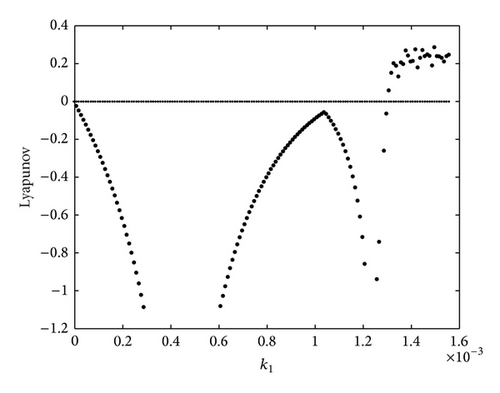
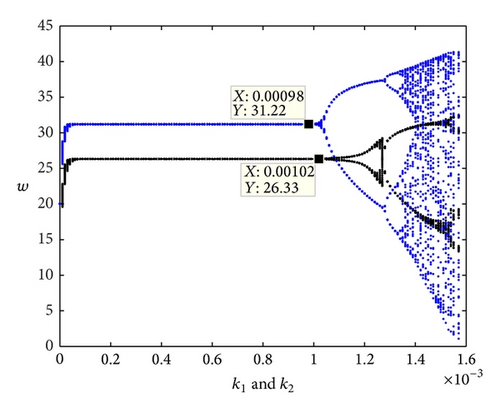
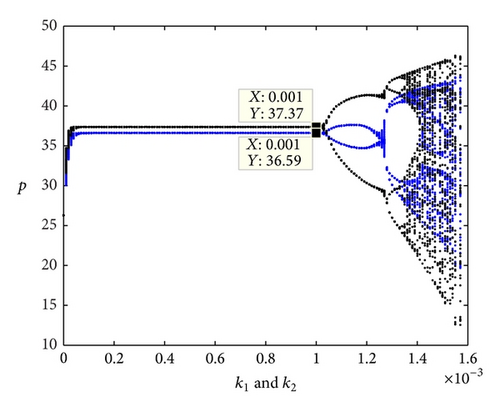
Figure 3(a) shows an attractor of the supply chain which is in stable state when k1 = k2 = 0.001. Figure 3(b) shows a chaos attractor of the supply chain which appears in a complex state when k1 = k2 = 0.0015; it is another chaos characteristic of the variables.
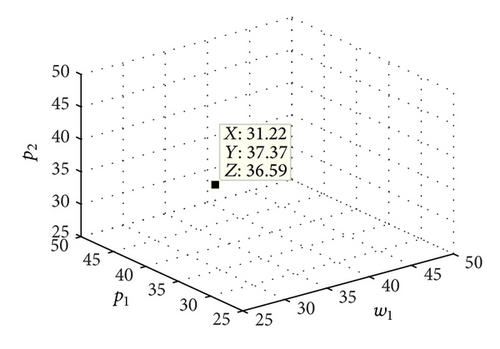
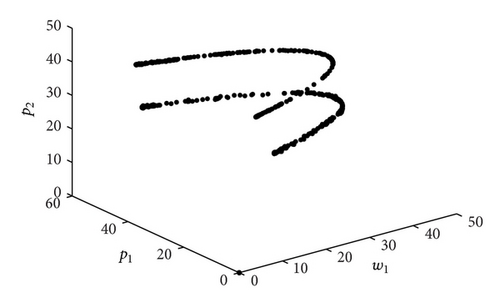
Proposition 1. The value of price adjustment speed determines whether the supply chain is stable or not; when we determine this value, each manufacturer should consider market reaction of the competitors and retailer. Only upstream and downstream enterprises keep stable, to ensure the stability of the supply chain and to maximize the enterprise’s profit.
(2) The Influence Which Change of Risk Preference Has on the Behaviors of the Two Manufacturers and the Retailer. Let k2 = 0.001, RR = 120; the value of other parameters is the same as in the previous assumption; we can obtain the price bifurcation diagrams of the two manufacturers and the retailer with change of k1, as shown in Figure 4. We can see that the stable region is not changed, wholesale price of the two manufacturers declines, and the retail price goes up with change of RR. Figure 5 shows the price bifurcation diagrams of the two manufacturers and the retailer with change of k1 when , the first bifurcation point is k1 = 0.00129, and the equilibrium value is (46.73, 26.4, 48.89, and 40.6). We can make a conclusion that the risk preference of the manufacturer can affect the stable region of system and change the equilibrium point of system, and the risk preference of the retailer cannot affect the stable region of system and change the equilibrium point of system.
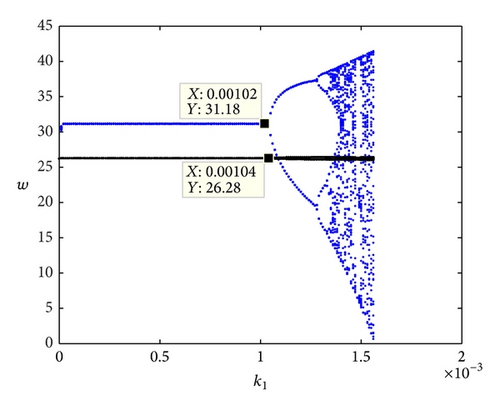
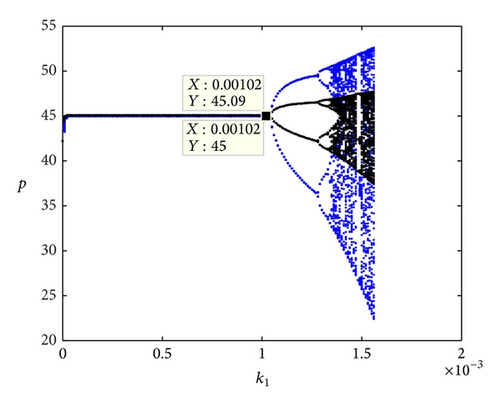
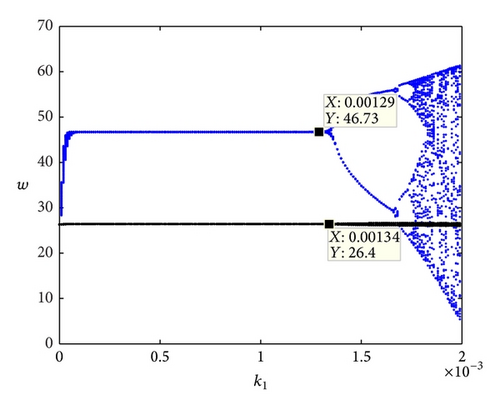
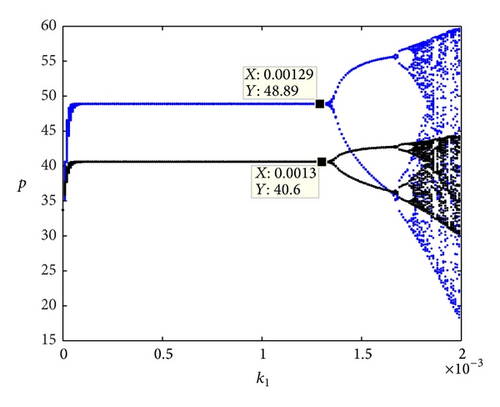
(3) The Influence Which the Uncertain Demand Has on the System Variable Behaviors. Because the demand forecasting exists errors, the customer demand is always uncertain. Next we will observe the price change of the two manufacturers and retailer with change of k1 when σ = 70, k2 = 0.001, and it is shown in Figure 6. We can see that, with σ increasing, the first bifurcation point of the system is k1 = 0.00105, and w1, w2, p1, and p2 are all falling.
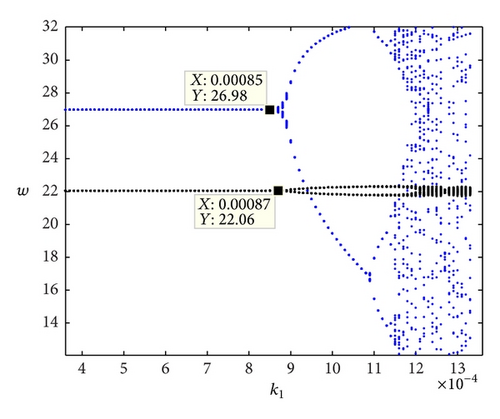
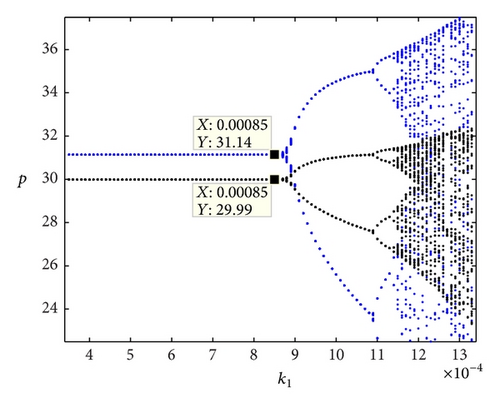
Proposition 2. Uncertain demand makes the supply chain access chaos quickly, and the wholesale price and the retail price decline. It is uncertain about their respective profit; thereby the competitiveness of the supply chain becomes weak.
(4) The Power Spectrum of Variables and the Sensitive Dependence on Initial Conditions. We adopt a cycle diagram method to estimate the power spectrum of variables. Next, we will observe the price change of the two manufacturers and retailer when k1 = k2 = 0.001 and the initial values are w1 = 20, w2 = 15; it is shown in Figure 7. We know that the supply chain is stable when k1 = k2 = 0.001, so the power spectrum of the variables is straight lines which conform to the attractor in Figure 3(a). When k1 = k2 = 0.0015, the supply chain is in chaos. From Figure 8, we can see that w1, w2, p1, and p2 vibrate with a frequency, w2 changes with approximate periodic motion, and range of movement of p1 is bigger than the one of p2.
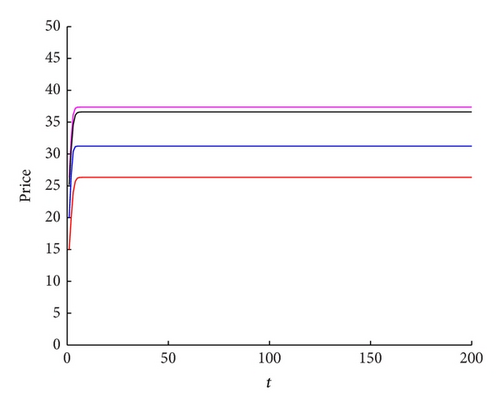
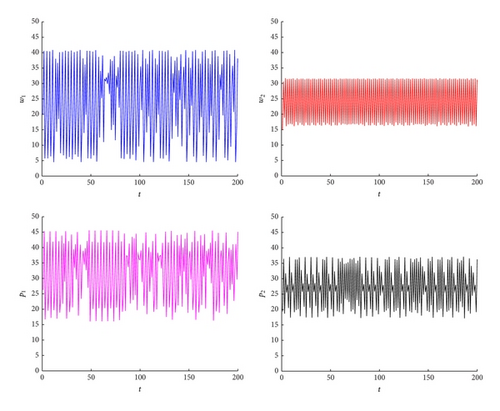
Then, we will observe the price change of the two manufacturers and the retailer when k1 = k2 = 0.0015 and (w1, w2) = (20.01, 15) and (20, 15) which has smaller change in w1 and no change in w2; they are shown in Figure 9. We can see that the price of the two manufacturers and retailer has distinct change. The sensitive dependence on initial conditions is another important characteristic of the chaotic system as it fully manifests the sensitive dependence on the initial conditions of the system (8).
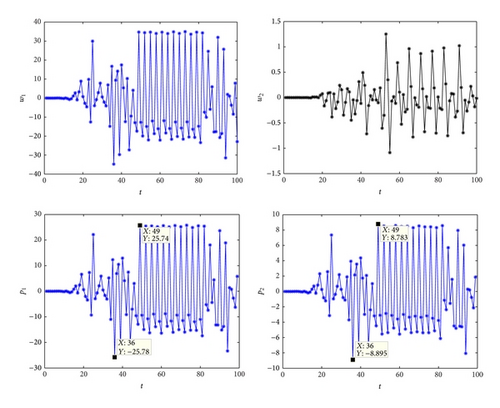
Through the above analysis, we know that the risk-averse supply chain has been in chaos. At this state, the price of the two manufacturers and the retailer changes disorderly from the beginning of the Nash equilibrium.
(5) The Effect of Parameter Change on the Profit. Figure 10 shows the profit bifurcation of the two manufacturers and retailer with changes of k1. Obviously, the profit bifurcation is similar to price bifurcation including period-doubling bifurcation, four-period-doubling bifurcation, and chaos state. Figure 11 shows the profit of the two manufacturers and retailer in 50 games when the system is in a stationary period, two-period-doubling bifurcation, and a chaotic period. In the different period, the fluctuation range of price of M1 is larger than that of M2. Tables 1, 2, and 3 give the profit data of the two manufacturers and retailer, respectively, in different periods with change of , and σ.
| Different periods | Stable period | Two-period-doubling bifurcation | Chaotic period |
|---|---|---|---|
| πR | 8159.76 | 8144.99 | 8175.85 |
| 8074.74 | 6126.11 | 2403.59 | |
| 8128.54 | 8149.99 | 8054.7 | |
| ∑ π | 24363.04 | 22421.09 | 18634.14 |
| Different periods | Stable period | Two-period-doubling bifurcation | Chaotic period |
|---|---|---|---|
| πR | 8182.74 | 8190.65 | 8203.86 |
| 15539.95 | 14331.78 | 12443.96 | |
| 8144.84 | 8136.82 | 8125.35 | |
| ∑ π | 31867.63 | 30659.25 | 28773.17 |
| Different periods | Stable period | Two period-doubling bifurcation | Chaotic period |
|---|---|---|---|
| πR | 6001.45 | 6009.92 | 6013.69 |
| 5918.76 | 4346.43 | 3573.6 | |
| 5972.61 | 5968.58 | 5967.1 | |
| ∑ π | 17892.81 | 16324.92 | 15554.38 |
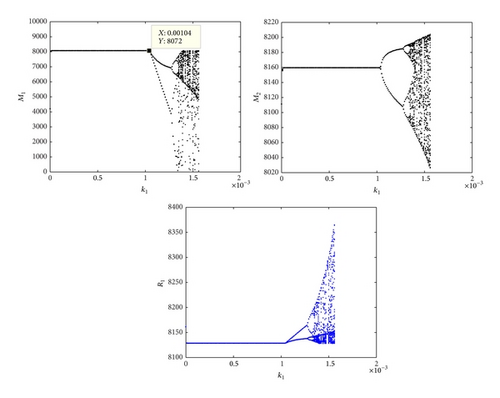
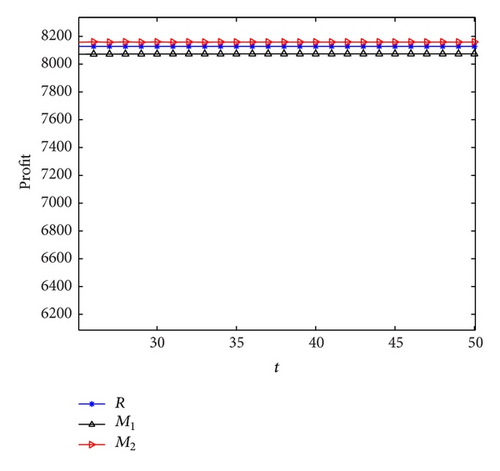
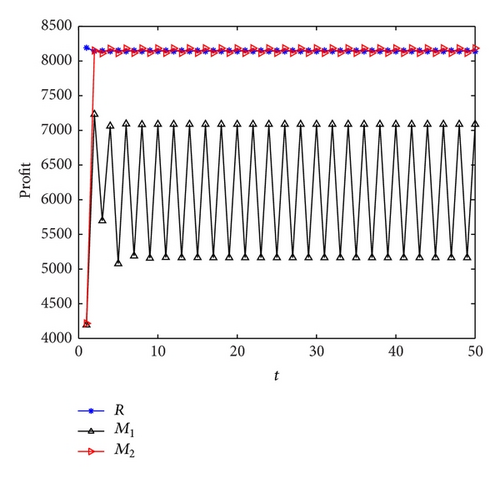
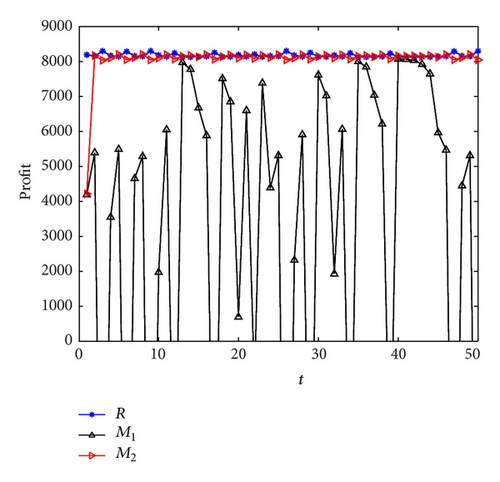
Proposition 3. First, the total profit of the system in the chaotic period is less than that in other periods. Second, the total profit of the system and respective profit of the two manufacturers and the retailer will increase with increase of and decrease with increase of σ. Third, when the system is in chaos, the profit of the two manufacturers will decrease, but the profit of retailer will increase. Namely, when the system goes into chaos, the retailer is a beneficiary. This is why some participants set out contract to avoid disordered competition in some situations and why some participants prefer chaotic market in some cases.
5. Chaos Control
Competitive manufacturers will certainly want to achieve maximum profit in the existing supply chain. Through the above analysis, we can see that the change of k1, k2, and σ often causes disorder behaviors in the market which are of disadvantage to the stability of the supply chain and the development of the enterprise. However, the participants often maximize their own profit by any kind of means in the process of marketization. So the market will be out of order and finally falls into chaos. It is particularly important that each participant should make rational strategic decision timely for making the system return to the stable equilibrium.
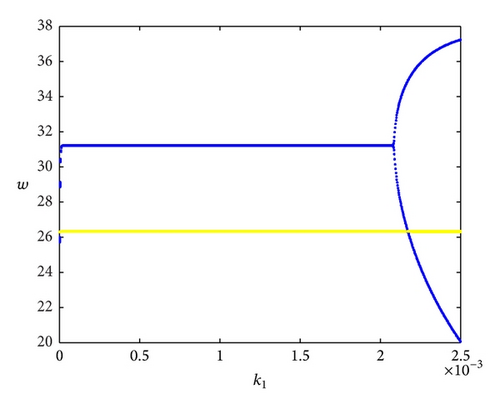
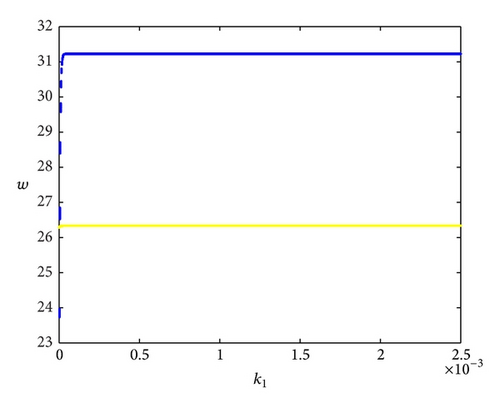
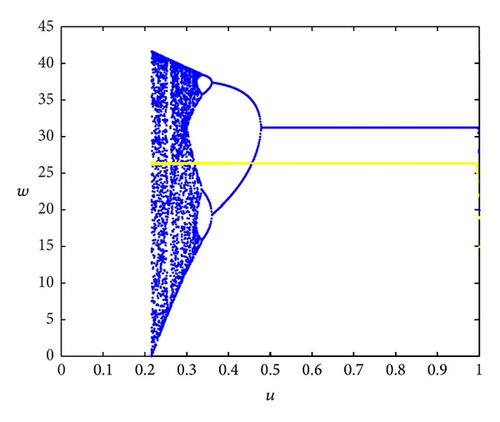
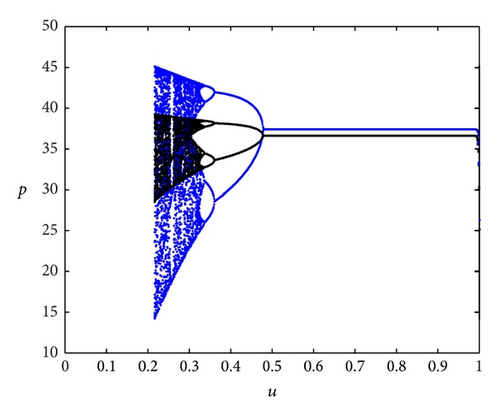
6. Conclusions
- (1)
The two manufacturers play the Bertrand game; when M1 changes its price adjustment speed, its wholesale price presents deterministic characteristics of chaos, and the wholesale price of M2 is influenced less. The price of retailer is influenced largely. When price adjustment speed of the two manufacturers changes at the same time, it has no effect on the optimal pricing strategy, the stable region of the supply chain gets smaller, and the two manufacturers all show complicated behavior characteristics.
- (2)
Increasing the risk tolerance level of the retailer does not impact stable region, but retail price will increase and wholesale price of the two manufacturers will fall. If M1 increases his risk tolerance level, the stability between M1 and the retailer is enhanced, and the two manufacturers’ wholesale price and products’ retail price go up. Uncertain demand makes the wholesale prices and retailer prices access chaos quickly, two manufacturers’ wholesale price and retail price decline, and total profit and their respective profit decrease.
- (3)
The total profit of the system in the chaotic period is less than that in other periods; it and respective profit of the two manufacturers and the retailer will increase with increase of and decrease with increase of σ. When the system is in chaos, the profit of the two manufacturers will decrease, but the profit of retailer will increase. Namely, when the system goes into the chaos, the weaker (retailer) is a beneficiary.
There are several possible directions for the future study. First, one can study three-echelon supply chain with complexity behaviors under the different game strategies considering the delay time, such as the Stackelberg game between the two manufacturers. Second, one can adopt a different form of demand function and, finally, other control methods may be applied in order to achieve different results.
Conflict of Interests
The authors declare that there is no conflict of interests regarding the publication of this paper.
Acknowledgments
The authors thank the reviewers for their careful reading and providing some pertinent suggestions. The research was supported by the National Natural Science Foundation of China (No. 61273231), Doctoral Fund of Ministry of Education of China (Grant No. 20130032110073) and supported by Tianjin University Innovation Fund.




